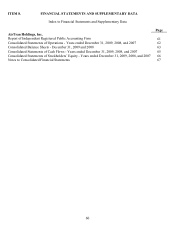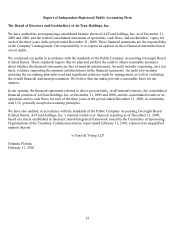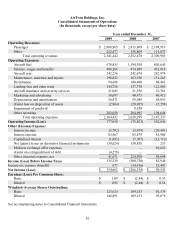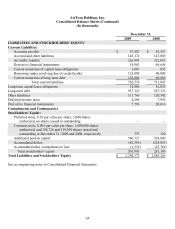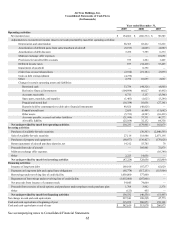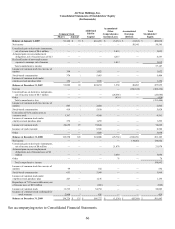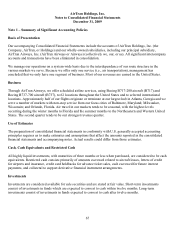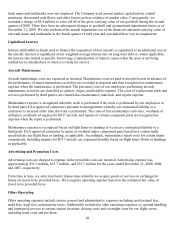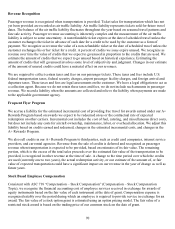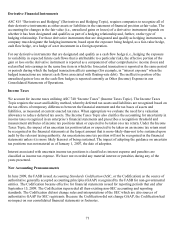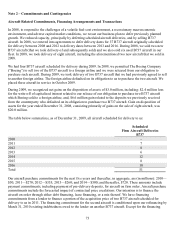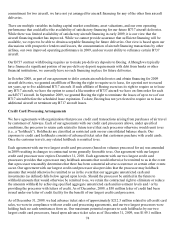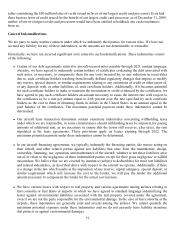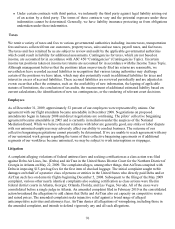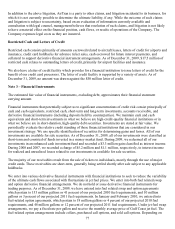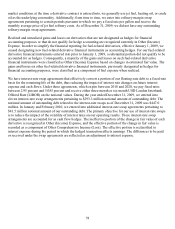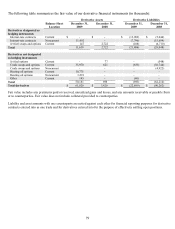Airtran 2009 Annual Report Download - page 79
Download and view the complete annual report
Please find page 79 of the 2009 Airtran annual report below. You can navigate through the pages in the report by either clicking on the pages listed below, or by using the keyword search tool below to find specific information within the annual report.70
Revenue Recognition
Passenger revenue is recognized when transportation is provided. Ticket sales for transportation which has not
yet been provided are recorded as air traffic liability. Air traffic liability represents tickets sold for future travel
dates. The balance of the air traffic liability fluctuates throughout the year based on seasonal travel patterns and
fare sale activity. Passenger revenue accounting is inherently complex and the measurement of the air traffic
liability is subject to some uncertainty. A nonrefundable ticket expires at the date of scheduled travel unless the
customer exchanges the ticket in advance of such date for a credit to be used by the customer as a form of
payment. We recognize as revenue the value of a non-refundable ticket at the date of scheduled travel unless the
customer exchanges his or her ticket for a credit. A percent of credits we issue expire unused. We recognize as
revenue over time the value of credits that we expect to go unused in proportion to the credits that are used. We
estimate the amount of credits that we expect to go unused based on historical experience. Estimating the
amount of credits that will go unused involves some level of subjectivity and judgment. Changes in our estimate
of the amount of unused credits could have a material effect on our revenues.
We are required to collect certain taxes and fees on our passenger tickets. These taxes and fees include U.S.
federal transportation taxes, federal security charges, airport passenger facility charges, and foreign arrival and
departure taxes. These taxes and fees are legal assessments on the customer. We have a legal obligation to act as
a collection agent. Because we do not retain these taxes and fees, we do not include such amounts in passenger
revenue. We record a liability when the amounts are collected and relieve the liability when payments are made
to the applicable government agency.
Frequent Flyer Program
We accrue a liability for the estimated incremental cost of providing free travel for awards earned under our A+
Rewards Program based on awards we expect to be redeemed on us or the contractual rate of expected
redemption on other carriers. Incremental cost includes the cost of fuel, catering, and miscellaneous direct costs,
but does not include any costs for aircraft ownership, maintenance, labor, or overhead allocation. We adjust this
liability based on credits earned and redeemed, changes in the estimated incremental costs, and changes in the
A+ Rewards Program.
We also sell credits in our A+ Rewards Program to third parties, such as credit card companies, internet service
providers, and car rental agencies. Revenue from the sale of credits is deferred and recognized as passenger
revenue when transportation is expected to be provided, based on estimates of its fair value. The remaining
portion, which is the excess of the total sales proceeds over the estimated fair value of the transportation to be
provided, is recognized in other revenue at the time of sale. A change to the time period over which the credits
are used (currently one to two years), the actual redemption activity, or our estimate of the amount of, or fair
value of expected transportation could have a significant impact on our revenue in the year of change as well as
future years.
Stock Based Employee Compensation
Consistent with ASC 718 “Compensation – Stock Compensation” (Compensation – Stock Compensation
Topic), we recognize the financial accounting cost of employee services received in exchange for awards of
equity instruments based on the fair value of each instrument at the date of grant. Compensation expense is
recognized ratably over the period during which an employee is required to provide service in exchange for an
award. The fair value of a stock option grant is estimated using an option pricing model. The fair value of a
restricted stock award is based on the trading price of our common stock on the date of grant.


